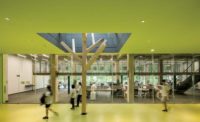In 2005, architects Jianxiang He and Ying Jiang were working on the Guangzhou Baiyun International Convention Center, a project by the Chinese-government-run CITIC ADI and its design partner, Belgian firm BURO II. At the time, He was the chief architect for CITIC ADI in South China and Jiang was working for BURO II. While the enormous project taught the two architects much about design, construction, and even their own society, they were left “feeling disappointed about the situation,” says Jiang, specifically about issues relating to “speed, quality, quantity, and powerful clients.” She adds: “Very few people care about the quality and cultural value of architecture. That’s really sad for us.”
So, He, 43 years old, and Jiang, 39, who are married, decided to open an independent studio in the southern Chinese city of Guangzhou and find private clients—no small feat, considering that so many projects in China are sponsored by the government. But the architects have developed a steady stream of work that allows them to tackle some of the most pressing problems facing their region, from its abandoned industrial sites to the lack of affordable housing to a skyline thick with anonymous skyscrapers.
The couple met through mutual friends while they were studying in Europe (she in Paris, he in Belgium); even though they both received their B.Arch. degrees at the South China University of Technology in Guangzhou, they didn’t cross paths there. Each grew up in Guangzhou and has powerful memories of it as an industrial hub and the communal living and working that came along with that. “After the reform policy, everything changed rapidly,” says He, referring to Chinese leader Deng Xiaoping’s economic reforms of the late 1970s and early 1980s. “A lot of this old industry went bankrupt. The city grew really fast, but within the city center, there were a lot of ruined conditions and vacant factories.”
Jiang and He have a fondness for these vacant factories. They’ve made their office at the top of a silo building in the city’s old downtown. For the 2013 Bi-City Biennale of Urbanism\Architecture, organized by Hong Kong and Shenzhen, China, the architects inserted new paths, stairs, and walkways into a former glass factory in Shenzhen. Many of the walkways were made of glass, allowing visitors views of different levels above and below them. And at an abandoned dye factory on a 20-acre site in Shenzhen, the architects converted three buildings into galleries and workshops, a museum, and a modest hotel. This was an unusual project, says Jiang, because most developers want to demolish these kinds of sites. Even though a conversion takes more time and effort—for both the developer and the architects—it is worth it to O-OFFICE and the client, who gets a distinctive property that stands out from the rest of the market. “There is something really special about these sites—the history, the people who used to work there,” says Jiang.
“We see these historic industrial buildings as a new opportunity for the city,” adds He. “Outside of this area, the city is generic—skyscraper housing, offices, shopping malls without real context. We try to keep a critical distance from that.”
O-OFFICE Architects
FOUNDED: 2007
DESIGN STAFF: 12
PRINCIPALS: Ying Jiang and Jianxiang He
EDUCATION: Jiang: Ecole d’Architecture de Versailles, D.P.L.G., 2004; South China University of Technology, B.Arch., 1999;
He: KU Leuven, M.Arch., 1999, M.E. in Arch., 2000; South China University of Technology, B.Arch., 1996
WORK HISTORY: Jiang: BURO II, Belgium and China, 2005–07; AAUPC, Paris, 2004–05;
He: CITIC ADI, 2003–07; VK Group, Belgium, 2001–03.
KEY COMPLETED PROJECTS: iD Town Art District, Shenzhen, 2014; Silo Reconversion, Shenzhen, 2013; Silo top office, Guangzhou, 2013; EMG Art Gallery, Guangzhou (all in China)
Key Current PROJECTS: Silver Tower, Nanning, 2016; Tian An Cloud Hall, Shenzhen, 2017 (both in China)



























Post a comment to this article
Report Abusive Comment